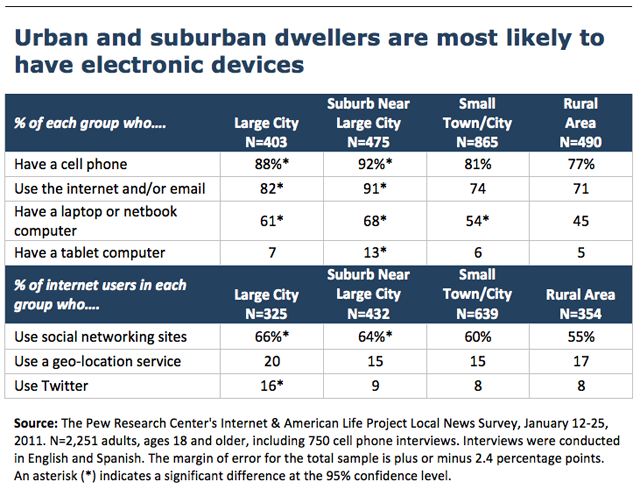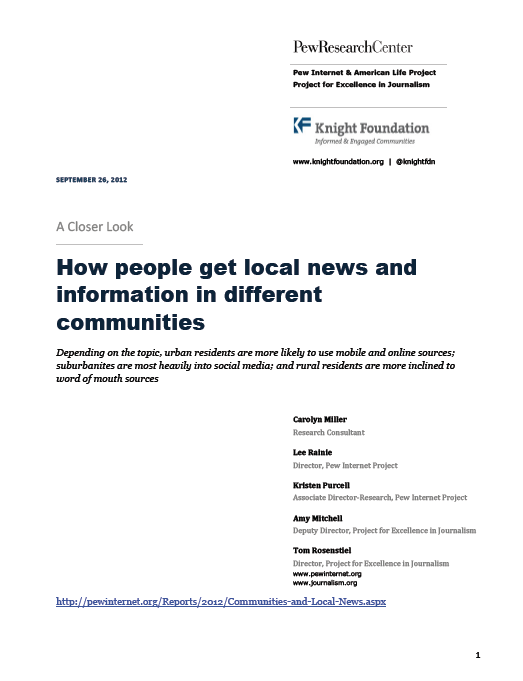In January, 2011 the Pew Research Center’s Project for Excellence in Journalism and Internet & American Life Project, in partnership with the Knight Foundation, conducted a nationally representative telephone survey of U.S. adults exploring local news consumption habits. Overall, the survey indicated that most adults follow what is happening in their local communities and that the local news ecosystem is complex. Rather than relying on one or two main sources of local news, most adults use a wide variety of both traditional and online sources depending on which local topic they are seeking information about.
This report reexamines those data with an eye toward how local news consumption practices vary by community type. Specifically, it focuses on the ways residents in large cities, suburbs, small towns and rural areas compare in their levels of interest in local news, the topics they are most interested in, and the sources they rely on to learn about those topics.
The results indicate that from large urban areas to rural communities, Americans often report similarly high levels of interest in news in general, in local news and information, and in national and international news. Moreover, similar percentages of adults report following the specific local topics asked about, regardless of the type of community in which they live.
Still, community differences do emerge in the number and variety of local news sources used, as well as the degree of “local news participation” and mobile news consumption. Many of the differences in local news consumption emerging from these data reflect the varying demographic composition of different community types in the U.S.
Some of the main differences include:
Urban residents: People who live in large cities rely on a wider combination of platforms for information than others and are more likely to get local news and information via a range of digital activities, including internet searches, Twitter, blogs and the websites of local TV stations and newspapers. Urbanites were also those least tied to their communities in terms of how long they lived in the community and how many people they know. They were the least interested of all groups in information about local taxes. At the same time, those who live in large cities, along with suburban residents, are the most likely to be digital “news participators” who email local stories to others, post material on social networking sites, comment on news stories online, or contribute to online discussions on message boards. Also along with suburbanites, they are more likely to get news via mobile devices. Additionally, they are the most likely to rely on local TV news for information about breaking news, weather, crime, politics, and traffic.

Suburban residents: Those who live in suburban communities are more likely than others to rely on local radio as a platform (perhaps because of relatively longer commuting times); they are more interested than others in news and information about arts and cultural events; and they are particularly interested in local restaurants, traffic, and taxes. Like urbanites, they are heavy digital participators who comment and share the news. These suburban residents rely mainly on the internet for information about local restaurants, businesses, and jobs. They look to television news for weather and breaking news.
Small town residents: Along with rural residents, people who live in smaller towns are more likely to rely on traditional news platforms such as television and newspapers to get local news; newspapers are especially important to them for civic information. Small town Americans prefer the local newspaper for a long list of information—including local weather, crime, community events, schools, arts and culture, taxes, housing, zoning, local government and social services. Residents of smaller towns are also the most likely to worry about what would happen if the local newspaper no longer existed.
Rural residents: Those who live in rural communities generally are less interested in almost all local topics than those in other communities. The one exception is taxes. They are also more reliant on traditional platforms such as newspapers and TV for most of the topics we queried. And they are less likely than others to say it is easier now to keep up with local information.
It is important to note that the choices about information acquisition are not necessarily the same in all communities. For instance, it might be the case in rural areas that the local newspaper and broadcast outlets are not online or have a very limited online presence and that is a determinant in whether residents get local information online or not. Our survey asked what consumers do in terms of information acquisition and what sources they “rely on.” It did not ask what they could do—that is, what information and sources are available in their communities. In many respects— but not all respects— people generally want similar types of news and information. In some communities, they have many choices and are quite deliberate in which platform they use to get which kind of information. In other communities, they have fewer choices.
